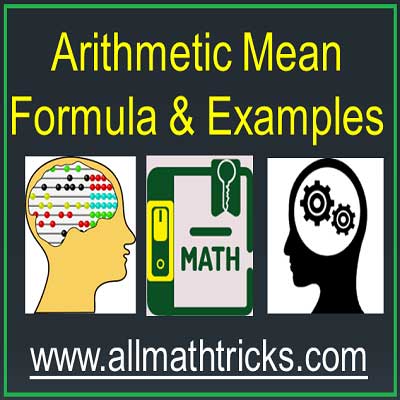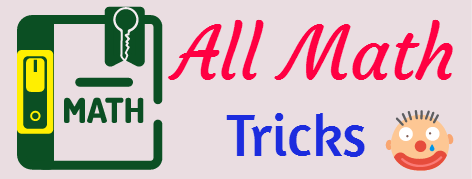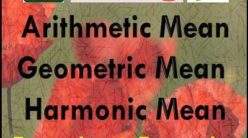In this article explained about Definition, Properties, Formula and Examples with Solutions of Arithmetic Mean
Basic Concept, formula with examples for Arithmetic Mean
The arithmetic mean “A” of any two quantities of ” a” and ” b”. Then
Here a, A, b are in A.P . We much have b – A = A- a ; Each being equal to the common difference
For any given two quantities it is always possible to insert any number of terms such that the whole series thus formed shall be in A.P. Then terms thus inserted are called the Arithmetic mean.
Properties of Arithmetic Mean
1. Mathematically Arithmetic Mean is also called average of that quantities
i.e If r1, r2, r3, r4, . . . . . rn be an finite A.P with n terms. Then arithmetic mean “A” of these numbers is given by
A = (1/n) [ r1 + r2 + r3 + r4,+. . . . . + rn ]
1. The “n” numbers r1, r2, r3, r4, . . . . . rn are said to be arithmetic means between “a” and “b” if a, r1, r2, r3, r4, . . . . . rn, b are in A.P
Here common difference of above A.P is
r1 + r2 + r3 + r4,+. . . . . + rn
similarly
2. Selection of the terms in an Arithmetic Progression
If number of terms is 3 then assume them as ” a-d, a & a+d” and common difference is “d”
If number of terms is 4 then assume them as ” a-3d, a-d, a+d & a+3d ” and common difference is “2d”
If number of terms is 5 then assume them as ” a-2d, a-d, a, a+d & a+2d ” and common difference is “d”
If number of terms is 6 then assume them as ” a-5d, a-3d, a-d, a+d , a+3d & a+5d ” and common difference is “2d”
Arithmetic Mean Examples
Example-1: In an A.M the sum of three consecutive terms is -3 and their product is 8. Then find the terms.
Solution: Let terms of A.M is, a, b, & c
According to A.M formula
a + c = 2b . . . . . . ( i )
a + b + c = -3 . . . . . . ( ii )
abc = 8 . . . . . . ( iii )
From equation ( i ) & ( ii ) b = -1
From equation ( ii ) , ( iii ) & b = -1
a = 2 and c = -4
So the sequence is 2, -1, -4
Example- 2: Find Arithmetic mean of numbers 1/2 and 1/3
Solution:
Arithmetic mean = [ (1/2) + (1/3) ] / 2 = 5/16
Example – 3: Find the second term of the given A.M terms , X ,
Solution: The terms can be rewritten as log2 3 , X, log2 12
⇒ 2X = log2 3 + log2 (4 x 3) = log2 3 + log2 4 + log2 3
⇒ 2 X = 2 ( log2 3) + 2 log2 2
⇒ 2 X = 2 ( log2 3) + (2 x 1 )
⇒ X = log2 3 + 1 = log2 3 + log2 2 = log2 6
Example – 4: If 10-r , a , r +2 are the consecutive terms of an A.P then find the value of ” a”
Solution: Given consecutive terms are 10-r , a , r +2
According to formula of Arthritic mean
⇒ (10-r ) + ( r +2 ) = 2a
⇒ 12 = 2a ⇒ a = 6
Example – 5: If (a+2), (4a -6) & (3a -2) are the consecutive terms of an A.P then find the value of ” a”
Solution: Given consecutive terms are (a+2), (4a -6) & (3a -2)
According to formula of Arthritic mean
⇒ (a+2) + (3a -2) = (4a -6)
⇒ 4a = 12 ⇒ a = 3
Example – 6: If 1/a , 1/b and 1/c are in A.P then bc, ca & ab are also in A.P
Solution: Given consecutive terms are 1/a , 1/b and 1/c are in A.P
Multiplying the above terms with ” abc”
Then abc/a , abc/b and abc/c are in A.P
So bc , ca & ab are in A.P
Example – 7: If a,b & c are in A.P then 1/bc, 1/ca & 1/ab are also in A.P
Solution: Given consecutive terms are a, b & c are in A.P
Multiplying the above terms with “1/abc”
Then a/abc , b/abc & c/abc are in A.P
So 1/bc, 1/ca & 1/ab are in A.P
Example -8: If 1/a,1/b & 1/c terms are in arithmetic progression then the terms of b+c/a, c+a/b & a+b/c are also in A.P
Solution: Given consecutive terms are 1/a , 1/b & 1/c are in A.P
Multiplying the above terms with ” a+b+c”
a+b+c/a , a+b+c/b & a+b+c/c are also in A.P
are in A.P
Add ” -1″ to all terms then
are in A.P
Example – 9: If 1/a,1/b,1/c terms are in arithmetic progression then the terms of b+c-a/a, c+a-b/b, a+b-c/c are also in A.P
Solution: Given consecutive terms are 1/a , 1/b & 1/c are in A.P
Multiplying the above terms with ” a+b+c”
a+b+c/a , a+b+c/b and a+b+c/c are also in A.P
are in A.P
Add ” -2″ to all terms then
are in A.P
are in A.P
are also in A.P
Example -10: If a, b & c terms are in arithmetic progression then the terms of b+c, c+a , a+b are also in A.P.
Solution: The given terms are a, b & c in A.P
According to Arithmetic mean formula
a + c = 2 b . . . . . . . . ( i )
Take the terms b+c, c+a , a+b
Add 1st and 3rd term of the above
i.e (b + c )+ (a +b) = (a +c) + 2b
Now substitute equation (i) in above
(a +c) + 2b = (a +c) + (a +c) = 2(a +c)
So The terms b+c, c+a , a+b are in A.P.

Related Articles
Arithmetic Progression Formulas
Arithmetic Progression Questions with Solutions
Arithmetic Mean formula with Examples
Geometric Progression formulas
Geometric Progression Examples
Harmonic Progression formulas and examples
Relation between AM, GM and HM





